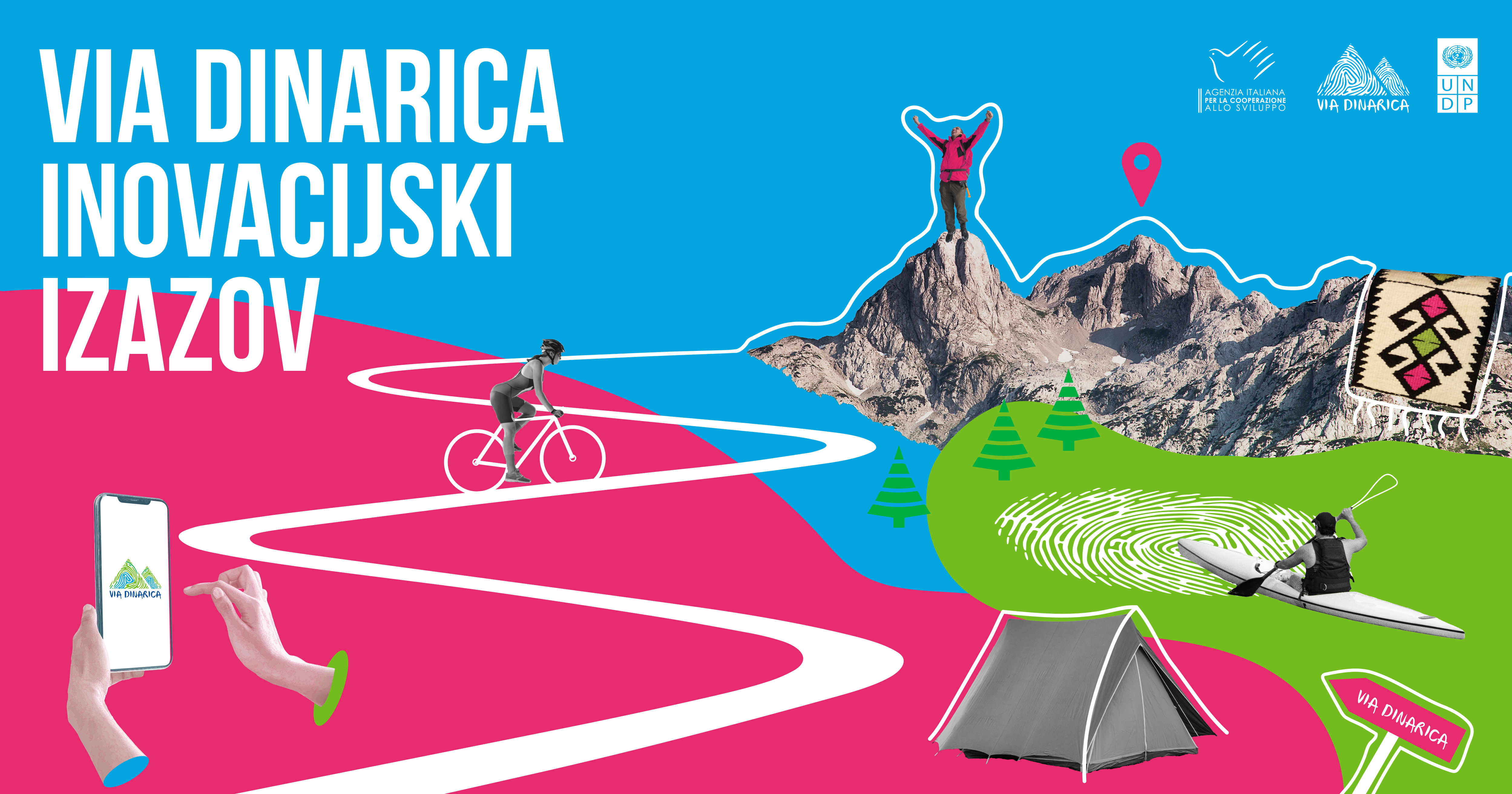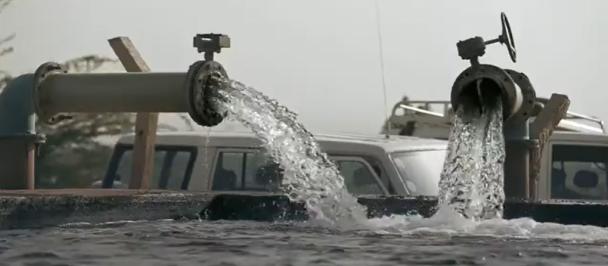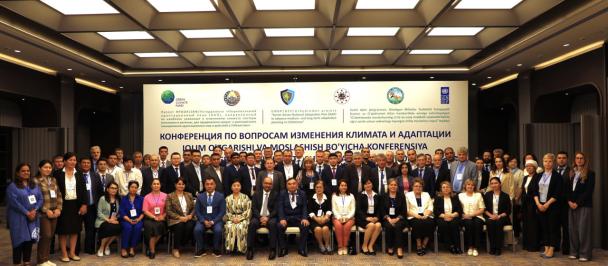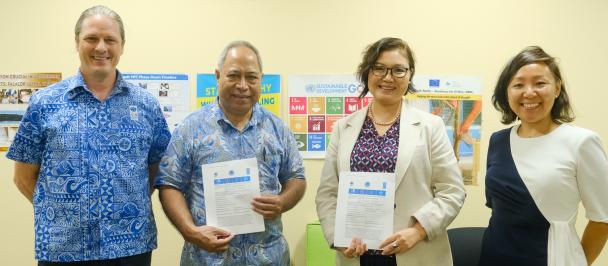About the project Sustainable Tourism for Green Development along the Via Dinarica Trails in Bosnia and Herzegovina
Via Dinarica Innovation challenge
April 25, 2024

The project "Sustainable Tourism for Green Development along the Via Dinarica Trails in Bosnia and Herzegovina" aims to support the development of sustainable tourism based on natural resources and to strengthen communities located near tourist attractions in Bosnia and Herzegovina. The project actively utilizes the achievements and multi-year experience of UNDP gained during the previous two phases of the Via Dinarica project in Bosnia and Herzegovina with the aim of further promoting Via Dinarica on the global tourism map. The project aims to establish tourism in Bosnia and Herzegovina based on sustainable approaches grounded in nature, gender-responsive green development, and the improvement of living standards. This goal will be achieved, among other things, through enhanced implementation of technology and innovation. In light of the lessons learned from the COVID-19 pandemic, which has reshaped tourism both globally and in Bosnia and Herzegovina, the project adopts a new approach with a greater focus on resilience. However, the COVID-19 crisis has opened up the opportunity for a new approach to tourism development, promoting sustainable tourism and environmental protection, increasing community and tourist awareness of nature, and intensifying the use of technologies. This creates multiple benefits that will aid the country's recovery from the pandemic and its transition to a sustainable and resilient tourism sector. Through this project, UNDP continues to expand its existing diverse partnerships and affirm the platform to support sustainable tourism in Bosnia and Herzegovina within the network of regional partners.
The project is part of a broader conceptual framework developed by UNDP for the development of sustainable tourism in 2020. It recognizes all the various elements and factors within this system, considering their interconnectedness and dynamics. As such, the project aims to support all key stakeholders in the revitalization and development of tourism along the Via Dinarica trails through a renewed approach paving the way for sustainable tourism in Bosnia and Herzegovina.
The project is being implemented in 77 local government units in Bosnia and Herzegovina, namely: Banovići, Banja Luka, Bihać, Bosanska Krupa, Bosanski Petrovac, Bosansko Grahovo, Bugojno, Čapljina, Čelinac, Donji Vakuf, Drvar, Foča, Fojnica, Gacko, Glamoč, Goražde, Gornji Vakuf/Uskoplje, Grude, Hadžići, Han Pijesak, Ilijaš, Istočni Drvar, Istočni Mostar, Istočni Stari Grad, Jablanica, Jajce, Jezero, Kakanj, Kalinovik, Kladanj, Ključ, Kneževo, Konjic, Kotor Varoš, Kreševo, Krupa na Uni, Kupres, Livno, Ljubuški, Maglaj, Mostar, Mrkonjić Grad, Neum, Nevesinje, Novi Travnik, Olovo, Pale (FBiH), Pale (RS), Petrovac-Drinić, Posušje, Prijedor, Prozor-Rama, Ravno, Ribnik, Rogatica, Rudo, Sanski Most, Sarajevo Centar and Sarajevo Stari grad, Sokolac, Srebrenica, Stolac, Šipovo, Teslić, Tomislavgrad, Travnik, Trebinje, Trnovo (FBiH), Trnovo (RS), Tuzla, Vareš, Višegrad, Vlasenica, Vogošća, Zavidovići, Zenica and Žepče.
The project is co-financed by the Italian Agency for Development Cooperation (AICS) and the United Nations Development Programme (UNDP) in Bosnia and Herzegovina.
In addition to physical infrastructure, there is a growing need for diversity and modernization of the tourism offer, as well as the introduction of technology and innovation for enhanced tourist experiences and broader promotion of the tourism potential of the Via Dinarica. The next generation of tourism services that promote natural, cultural, and historical resources while conserving and valorizing them through digital and innovative solutions and approaches can significantly contribute to sustainable tourism development and improvement of living standards in rural areas (and beyond).
Therefore, this innovation challenge represents an important step towards enhancing tourism services along the Via Dinarica and further developing sustainable tourism in Bosnia and Herzegovina in line with contemporary market trends.
The innovation challenge is launched with the aim of modernizing and enhancing tourism services along the trails and sites of the Via Dinarica through the support of sustainable, applicable, and innovative solutions. The innovation challenge for grant funding is implemented within the project activity called "Traditional and Modern Tourism Services Based on Natural, Cultural, and Historical Heritage," developed in collaboration with experts and active communities. Through the implementation of the innovation challenge, the project will support innovative nature-based solutions for sustainable tourism development developed in collaboration with local communities and the private sector along the Via Dinarica trails, as well as in protected natural areas. This includes all categories of protection (national parks, natural landmarks, protected habitats, protected landscapes, areas with sustainable use of natural resources, as well as Ramsar sites).
Within this innovation challenge, high-quality innovative solutions are expected, which will result from synergistic thinking and action of various stakeholders in local communities. These solutions should represent a response to real problems in local communities in the areas of environmental protection, technology application, as well as integration of cultural and artistic content in the development of sustainable tourism services.
The plan is to select and support the implementation of the top 3 highest-rated innovative solutions. These are innovative solutions that enable the improvement of existing or creation of new tourism services along the trails and sites of the Via Dinarica and that adhere to the following basic principles:
- The solution is new and original along the trails and sites of the Via Dinarica.
- The solution respects or enhances the ecological sustainability of the location.
Through the implementation of the innovation challenge, UNDP aims to enhance the overall tourist experience on the Via Dinarica trails, making it more attractive, interactive, and accessible to a diverse range of visitors. The outcome of the challenge is the creation of new, innovative, sustainable, and replicable tourism services developed through close collaboration and synergy among relevant stakeholders in local communities, including businesses, government, non-governmental sector, and public institutions.
EXPECTED RESULTS
To further enhance tourism services and promote the Via Dinarica trails, this innovation challenge expects high-quality innovative solutions that result from synergistic thinking and action among various stakeholders in local communities. These solutions are expected to respond to real problems in local communities related to environmental protection, the need for technology application, or the integration of cultural and artistic content in the development of sustainable tourism services.
THEMATIC AREAS AND CATEGORIES
The innovation challenge invites submissions within the following thematic areas:
- Green Initiatives
- Ideas for the development and implementation of environmentally friendly practices or initiatives that involve the local community, the tourism sector, and tourists/visitors, and promote responsible tourism on the trails and sites of the Via Dinarica, such as: i) Innovative solutions for reducing or eliminating waste in tourist facilities or destinations located along the Via Dinarica trails, whether through smart resource management, innovative resource utilization practices, or promoting the reuse of materials; ii) Innovative solutions that promote energy or resource efficiency in tourist facilities along the Via Dinarica trails; iii) Innovative solutions that promote sustainable mobility and logistics; and iv) Innovative proposals for preserving species diversity or ecosystems at tourist destinations and innovatively incorporating nature protection measures into the tourism offerings of destinations.
- Innovative practices that enhance environmental conservation while providing economic opportunities to local communities and fostering collaboration between the tourism sector and local communities, including solutions for implementing circular business models in the tourism sector, contributing to sustainable development along the Via Dinarica trails.
2. Technology integration
- Integration of advanced technologies into tourism services, such as personalized digital tours generated by artificial intelligence recommending a combination of attractions, activities, and services based on the interests, physical readiness, and other parameters inputted by the tourist; or virtual tours using augmented and/or virtual reality, which would provide tourists with new, authentic experiences by bringing historical, cultural, and other aspects of destinations to life.
- The development of mobile applications and online platforms that provide real-time information, navigation assistance, and interactive elements to enhance the tourist experience on the Via Dinarica trails.
- The development and delivery of capacity-building programs for utilizing existing digital tourism tools and platforms to better promote the tourist offer on the Via Dinarica trails, including mentoring and support for pilot implementation in practice.
3. Integration of cultural and artistic content
- Innovative solutions for integrating any of the nine types of arts, as well as crafts or folklore, to enrich the tourist offer of the Via Dinarica through a unique artistic expression and partnership with local creative industries, artists, and cultural organizations.
- Promotion of gender-sensitive local traditions (e.g., culinary experiences) through the development of innovations that contribute to the promotion of these values.
EXAMPLES OF INNOVATION CHALLENGE
On the following page, you can check out examples of innovation challenges: UNWTO Awake Tourism Challenge | UNWTO Innovation Challenges.
AWARDS:
The total prize fund within the Innovation Challenge amounts to 42.000,00 BAM, whereby, based on a competitive process, the implementation of the top three ranked innovative solutions will be supported regardless of the thematic areas and categories.
The requested funding amount for each proposed solution can range from a minimum of 10.000,00 BAM to a maximum of 14.000,00 BAM.
Applicants are encouraged to provide co-financing for the implementation of the proposed innovative solutions, which will be additionally scored. Co-financing must be material/financial, and it is the funds that the applicant must secure before the implementation of the solution begins.
The project reserves the right not to distribute all available funds in case the quality of the proposed solutions is not satisfactory and does not meet all defined criteria.
In the event that the total amount of the prize fund allocated for the top three solutions is not fully distributed, the Evaluation Committee retains the discretionary right to allocate the remaining funds to the next-ranked solution, in line with the objectives and purpose of this challenge. Such a decision will be made based on fairness and transparency criteria to maximize the positive impact of the challenge and promote excellence in the submitted solutions. Any decision by the Committee will be promptly communicated and aimed at ensuring a fair distribution of available funds.
EVALUATION CRITERIA
First Phase - Initial Idea Proposal
The applicant's idea is briefly presented in the format of "identified problem - potential solution" through a simple form on the Open Innovation Platform.
The criteria based on which the initial idea proposal will be evaluated by the expert jury are:
- Is the proposed solution submitted for the trails and sites of the Via Dinarica in Bosnia and Herzegovina? (Yes/No)
- Has the applicant provided proof of citizenship (individuals) / Company registration certificate/Extract from the court register (original or certified copy – legal entities)? (Yes/No)
- Has the applicant correctly completed the initial idea proposal on the platform? (Yes/No)
- Does the proposed idea directly and clearly address the question of the Innovation Challenge "What innovative approaches can we apply to transform the trails and sites of the Via Dinarica into a sustainable and modern tourist destination?" (Yes/No)
- Is the proposed idea innovative, original, and new to the local community and beyond? (Yes/No)
Second Phase - Detailed Solution Proposal
| Criteria | Value |
Expert Jury Evaluation Based on the Following Criteria:
| 50% |
Evaluation based on the applicant's partnership with local stakeholders in developing the idea and implementing the proposed solution, based on the following criteria:
| 15% |
Evaluation based on provided co-financing:
| 15% |
| Evaluation based on public voting | 20% |
PARTICIPATION CRITERIA
The participation criteria for this innovation challenge include:
- Acceptance of the terms of use of the Open Innovation Platform and thereby the participation conditions in the innovation challenge.
All applicants interested in participating in the "Via Dinarica Innovation Challenge" will be required to accept the Terms and conditions of using the Open Innovation Platform through which they will submit their concepts for proposed solutions. Applicants should pay special attention to Article 3. User Contributions of the Terms of Use of the Platform, where, among other things, it states:
"Your contributions to the Platform are entirely voluntary, non-confidential and free. You grant UNDP and all organizers (as defined below), the Innovation Challenge Partners and other Users an unlimited, permanent, irrevocable, non-exclusive, wholly unrestricted, and royalty-free worldwide license to use any idea, contributions, or other materials, which you submit to this Platform without limitation of any kind and any payment or further consideration of any kind, or permission or notice, to you or any third party."
- If the proposed solutions use data from other owners, applicants must have written permission for use - it will be necessary to provide evidence of permission or a license to use the data, if it is not open data.
- Intellectual property rights to the ideas and subsequently developed solutions belong to UNDP.
- Applicants must be willing, if awarded one of the top three prizes, to fund the development of their innovative idea independently. After completing the work and providing relevant evidence, as defined in the contract, they may receive reimbursed costs, which can be paid in multiple installments, up to the amount allocated in the prize fund.
WHO CAN APPLY?
The innovation challenge is open to applicants from Bosnia and Herzegovina. Applicants eligible to apply for this call are:
Individuals, tourist companies and trades, tourist operators and agencies, associations, organizations, sports clubs, mountaineering clubs, educational institutions, local self-government units, public institutions, and management bodies of protected natural and cultural values.
The proposed solutions must be implemented in the locations of the white, green and blue paths of the Via Dinarica in the following local self-government units in Bosnia and Herzegovina:
Banovići, Banja Luka, Bihać, Bosanska Krupa, Bosanski Petrovac, Bosansko Grahovo, Bugojno, Čapljina, Čelinac, Donji Vakuf, Drvar, Foča, Fojnica, Gacko, Glamoč, Goražde, Gornji Vakuf/Uskoplje, Grude, Hadžići, Han Pijesak, Ilijaš, Istočni Drvar, Istočni Mostar, Istočni Stari Grad, Jablanica, Jajce, Jezero, Kakanj, Kalinovik, Kladanj, Ključ, Kneževo, Konjic, Kotor Varoš, Kreševo, Krupa na Uni, Kupres, Livno, Ljubuški, Maglaj, Mostar, Mrkonjić Grad, Neum, Nevesinje, Novi Travnik, Olovo, Pale (FBiH), Pale (RS), Petrovac-Drinić, Posušje, Prijedor, Prozor-Rama, Ravno, Ribnik, Rogatica, Rudo, Sanski Most, Sarajevo Centar i Sarajevo Stari grad, Sokolac, Srebrenica, Stolac, Šipovo, Teslić, Tomislavgrad, Travnik, Trebinje, Trnovo (FBiH), Trnovo (RS), Tuzla, Vareš, Višegrad, Vlasenica, Vogošća, Zavidovići, Zenica i Žepče.
There are no restrictions in terms of the number of partners, but it is necessary that each partner has a clearly defined role within the implementation of the innovative solution. In case of winning one of the three first places, funds are awarded exclusively to the applicant.
An agreement on the allocation of funds will be signed with the awarded individuals or legal entities, which will define the conditions, method and dynamics of spending the funds.
HOW TO APPLY?
In order to apply for the challenge, participants will need to do the following:
First phase
- Visit the open innovation platform at www.otvoreneinovacije.ba and register here.
- Get informed about the thematic focus of the challenge and the key question to which the challenge seeks answers and submit an idea on the Open Innovation Platform.
An online information session for interested applicants will be organized on May 8, 2024 (Wednesday) at 11 am. It will be an opportunity for everyone to hear more about the challenge itself, the chosen topic, the Open Innovation Platform, how to apply, the stages of the challenge, and get answers to potential questions. All those interested in participating in the online information session must register no later than May 6, 2024 by 4 p.m. using the following form HERE.
Second phase
- If the applicant passes to the second stage based on the grades from the first stage, he will access the detailed elaboration of the solution also through the form on the Open Innovation Platform.
TIME AND FINANCIAL FRAME
The "Via Dinarica Innovation Challenge" will be implemented in the following time intervals (tentative dates):
1) Challenge on the Open Innovation Platform:
First phase: initial idea proposal (April 23, 2024 - May 21, 2024).
Second phase: detailed solution proposal (May 29, 2024 - June 26, 2024).
2) Implementation of winning solutions: July 2024 - November 2024.
The total financial framework for this innovation challenge is 42.000,00 BAM.
The amount of requested funds for each proposed solution can be from a minimum of 10.000,00 BAM to a maximum of 14.000,00 BAM.

 Locations
Locations

